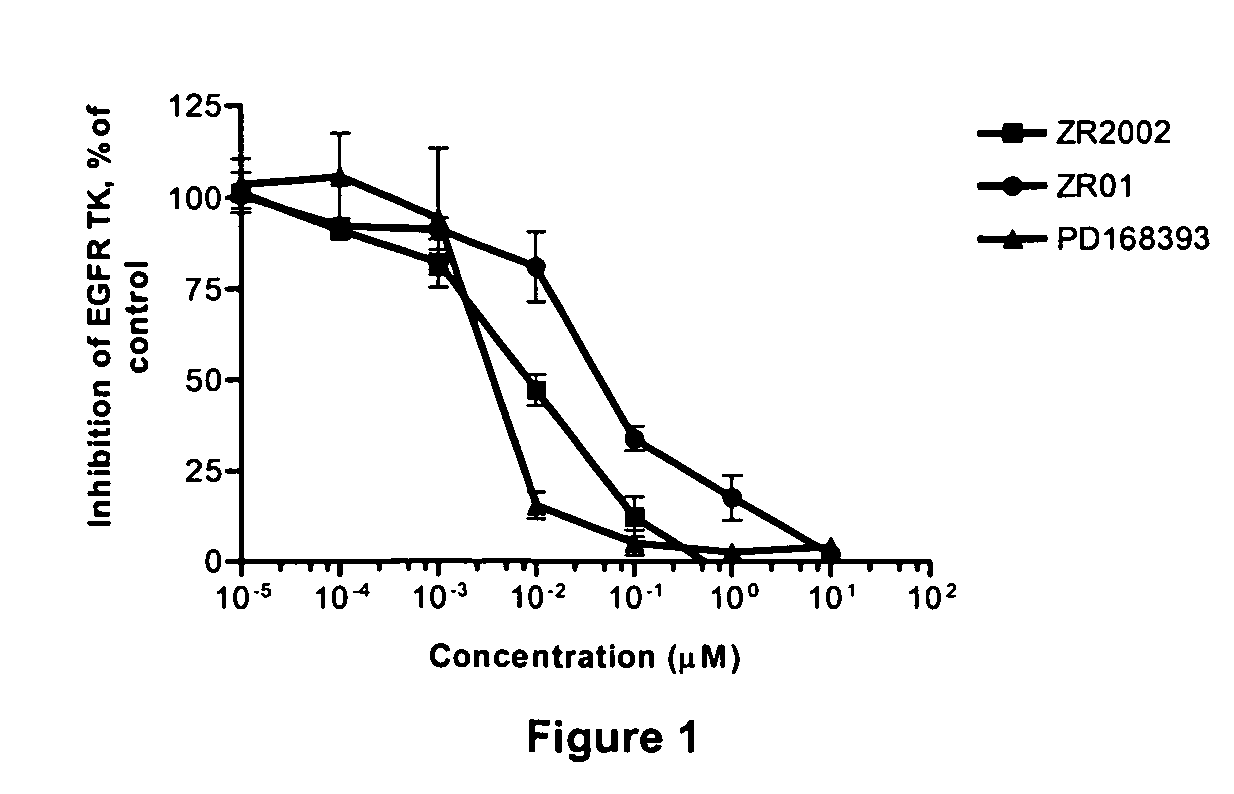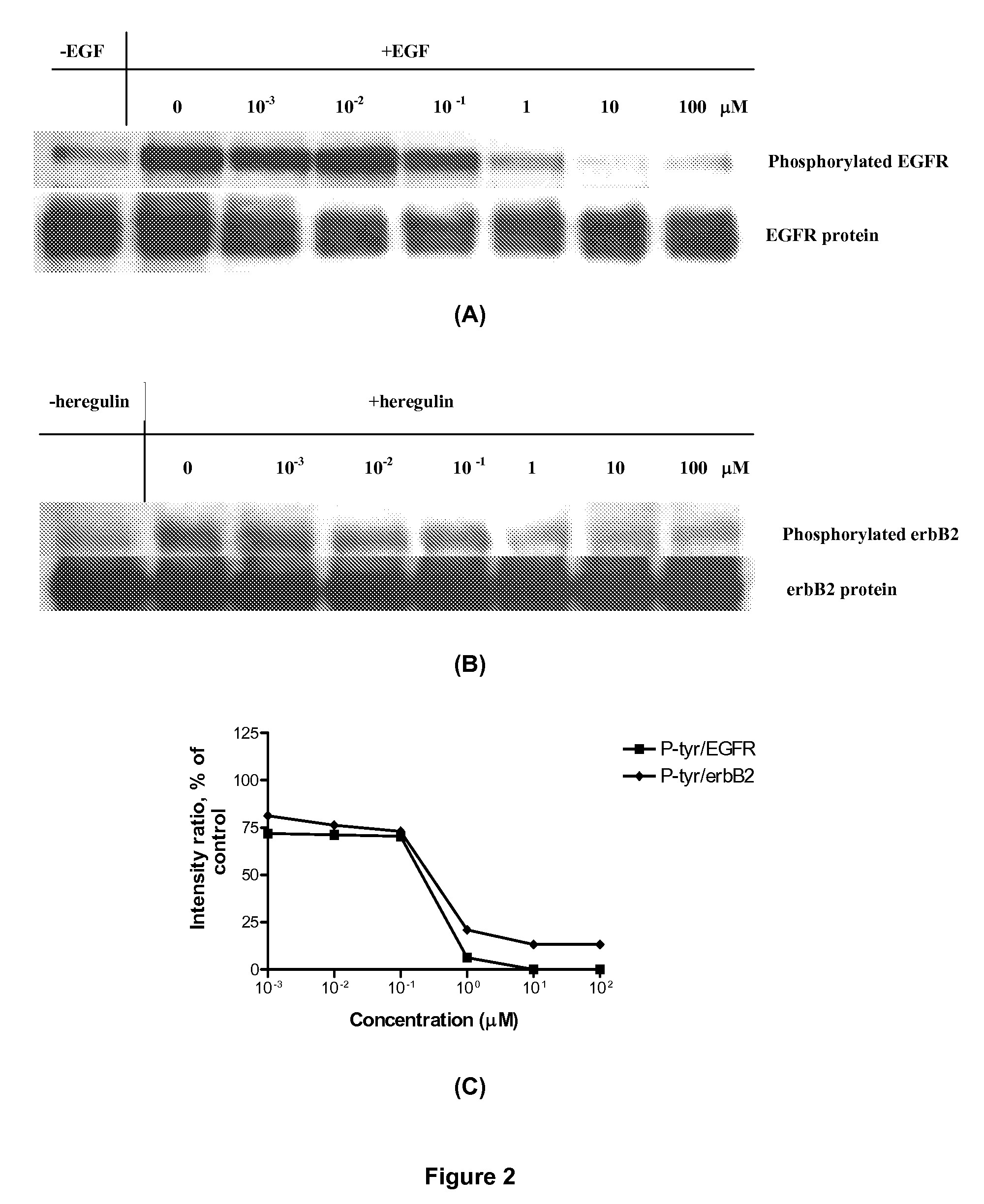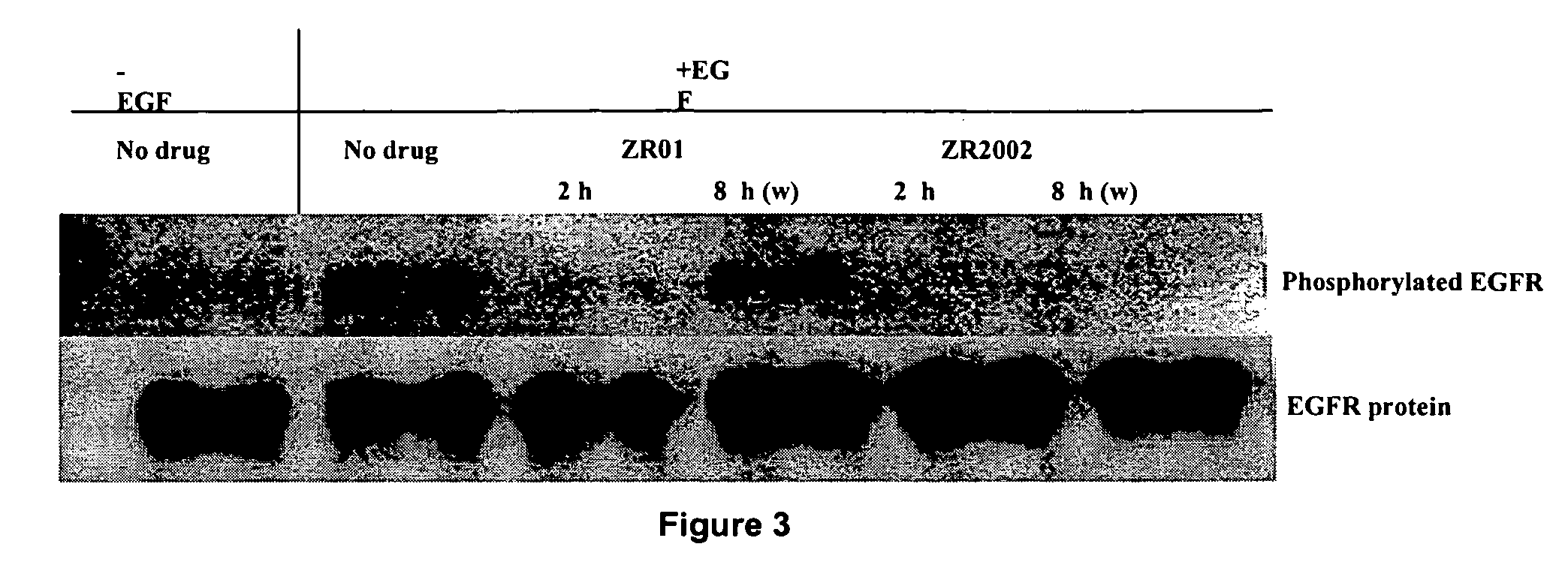Combi-molecules having EGFR and DNA targeting properties
a technology of egfr and dna, which is applied in the field of combimolecules and bicombimolecules having egfr and dna targeting properties, can solve the problems of synergistic killing and good toxicity profile of egfr-overexpressing cells, and achieves significant inhibition of downstream signaling, inhibiting phosphorylation, and blocking heregulin-stimulated mapk phosphorylation
- Summary
- Abstract
- Description
- Claims
- Application Information
AI Technical Summary
Benefits of technology
Problems solved by technology
Method used
Image
Examples
example 1
Synthesis of ZR2002
[0184]The amino compound (1.26 g, 0.4 mmol) was stirred in dry acetonitrile (40 mL) under argon, after which the solution was cooled to −5° C. followed by the addition of nitrosonium tetrafluoroborate (0.9 g, 0.8 mmol) in acetonitrile. The resulting clear solution was stirred for 1 hour at −5° C. to permit the formation of the diazonium salt. It was then added dropwise to another solution of ether (30 mL), water (5 mL), and Et3N (6 ml) and 2-chloroethylamine hydrochloride (3.24 g, 2.8 mmol) at 0° C. The mixture was stirred at room temperature overnight followed by the subsequent extraction with ethyl acetate. The organic layer was dried over potassium carbonate and evaporated to provide the crude product which was purified by chromatography using a basic alumina column (1:4 triethylamine-AcOEt) to give an oil that solidified upon addition of petroleum ether and ether to give (400 mg, 27%) of ZR2002; mp 167° C.; ESI m / z 377.3 (MH+ with 79Br), 379.2 (MH+ with 81Br),...
example 2
Synthesis of ZRBA1 (1-{4-[(3-Chlorophenyl)amino-6-quinazolinyl}-3-(2-N,N-dimethylaminoethyl)triazene)
[0185]The amino compound (500 mg, 1.70 mmol) was stirred in dry acetonitrile (15 mL) under argon, after which the solution was cooled to −5° C. followed by the addition of nitrosonium tetrafluoroborate (430 mg, 3.70 mmol) in acetonitrile. The resulting clear solution was stirred for 1 hour at −5° C. to permit the formation of the diazonium salt. It was then added dropwise to another solution of ether (20 mL), water (3 mL), and Et3N (1 ml) and N,N-dimethylethylenediamine (1.50 ml, 11.90 mmol) at 0° C. The mixture was stirred at room temperature overnight followed by the subsequent extraction with ethyl acetate. The organic layer was dried over potassium carbonate and evaporated to provide the crude product which was purified by chromatography using a basic alumina column (1:3 triethylamine-AcOEt) to give an oil that solidified upon addition of petroleum ether and ether to give (200 mg...
example 3
Synthesis of ZRBA2 (1-{4-[(3-Chlorophenyl)amino-6-quinazolinyl}-3-(2-pyrrolidinoaminoethyl)triazene)
[0186]The amino compound (100 mg, 0.37 mmol) was stirred in dry acetonitrile (5 mL) under argon, after which the solution was cooled to −5° C. followed by the addition of nitrosonium tetrafluoroborate (86 mg, 0.74 mmol) in acetonitrile. The resulting clear solution was stirred for 1 hour at −5° C. to permit the formation of the diazonium salt. It was then added dropwise to another solution of ether (10 mL), water (1 mL), and Et3N (0.36 ml) and 1-(2-aminoethyl)pyrrolidine (0.32 ml, 2.59 mmol) at 0° C. The mixture was stirred at room temperature overnight followed by the subsequent extraction with ethyl acetate. The organic layer was dried over potassium carbonate and evaporated to provide the crude product which was purified by chromatography using a basic alumina column (1:4 triethylamine-AcOEt) to give an oil that solidified upon addition of petroleum ether and ether to give (40 mg, ...
PUM
| Property | Measurement | Unit |
|---|---|---|
| excitation wavelength | aaaaa | aaaaa |
| concentrations | aaaaa | aaaaa |
| wavelength | aaaaa | aaaaa |
Abstract
Description
Claims
Application Information
 Login to View More
Login to View More - R&D
- Intellectual Property
- Life Sciences
- Materials
- Tech Scout
- Unparalleled Data Quality
- Higher Quality Content
- 60% Fewer Hallucinations
Browse by: Latest US Patents, China's latest patents, Technical Efficacy Thesaurus, Application Domain, Technology Topic, Popular Technical Reports.
© 2025 PatSnap. All rights reserved.Legal|Privacy policy|Modern Slavery Act Transparency Statement|Sitemap|About US| Contact US: help@patsnap.com



